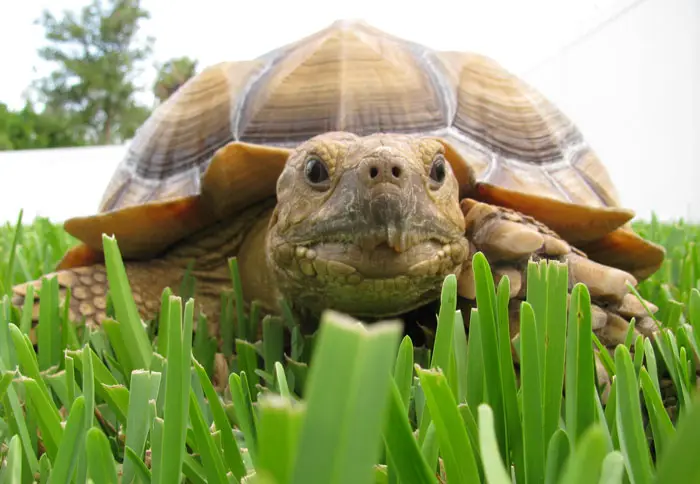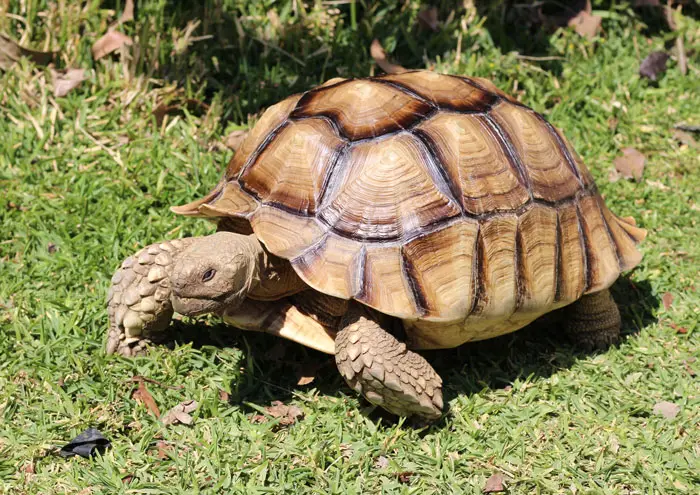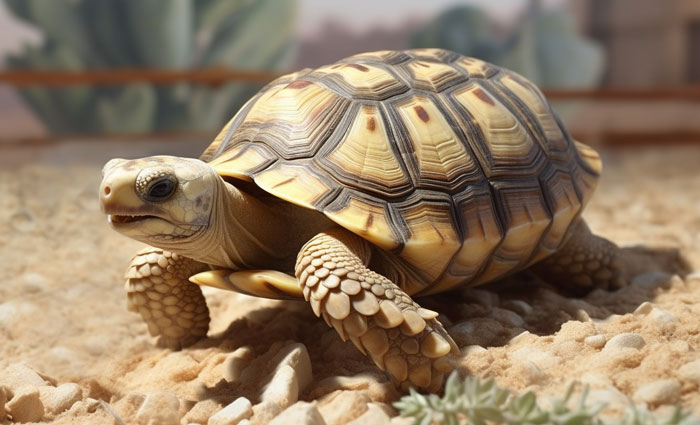Do Sulcata Tortoises Hibernate? How, When, How Long?
Sulcata tortoises are fascinating reptiles that can live for over 100 years. They are popular pets among reptile enthusiasts due to their docile nature and low maintenance. However, as with any pet, proper care is essential, especially during cold periods.
Do Sulcata tortoises hibernate? No, they do not. Hibernation is a state of inactivity and decreased metabolic rate that many animals enter during cold weather to conserve energy and survive winter. However, Sulcata tortoises are not equipped to enter this state. They are adapted to live in hot, dry climates and cannot tolerate cold temperatures.
This article will cover caring for a Sulcata tortoise during the winter, among other topics. Whether you’re a new or experienced Sulcata tortoise owner, this article will provide useful information to help you keep your pet healthy and happy during the colder months.
Do Sulcata Tortoises Hibernate?
Contents
No. Sulcata tortoises do not hibernate. Hibernation is a natural adaptation that some animals undergo in response to seasonal changes. During hibernation, an animal’s metabolic rate slows significantly, and its body temperature drops.

This allows the animal to conserve energy and survive the winter months when food and water may be scarce. Hibernation typically occurs when temperatures begin to fall, and animals emerge from hibernation in the spring when temperatures rise again.
While some species of tortoises do hibernate, such as the Russian tortoise, Hermann’s tortoise, and the Greek tortoise, others do not.
For example, the Red-footed tortoise, the African spurred tortoise, and the Leopard tortoise do not hibernate. They require consistent temperatures and lighting throughout the year.
Do Sulcata tortoises brumate?
Yes. Sulcata tortoises brumate. Brumation is a state of inactivity and slowed metabolism that reptiles and amphibians go through during the winter months. Brumation and hibernation are both states of inactivity and slowed metabolism that animals go through during the colder months.

However, there are some key differences between the two.
- For starters, brumation is often less intense than hibernation. While animals that hibernate can significantly reduce their body temperature and appear to be in a state of suspended animation, animals that brumate typically only reduce their activity levels and metabolism.
- Second, the timing and duration of brumation and hibernation can differ. Brumation can occur in response to temperature and light changes, whereas a change in day length typically triggers hibernation.
- Furthermore, animals that hibernate can do so for months, whereas animals that brumate can only do so for a few weeks.
- During brumation, Sulcata tortoises, such as a burrow, often retreat to a warm and dry location, reducing their activity levels and metabolism. This helps them conserve energy and survive the colder months when food and water are scarce.
It’s important to note that hibernation is a natural process that occurs in response to environmental cues and cannot be induced or forced in a pet tortoise. Attempting to force a tortoise to hibernate can be dangerous and may lead to health problems.
How To Take Care Of A Sulcata Tortoise During Winter?
Sulcata tortoises are adapted to live in hot and dry environments. They may struggle to cope with the colder temperatures and higher humidity levels common during cold periods.

Pet owners can take several steps to keep their Sulcata tortoise healthy during the cold weather, including.
Ensure Ideal Temperature
Sulcata tortoises require a warm, dry environment to thrive, and they can become stressed or even sick if exposed to cold temperatures.
Keeping a temperature gradient in your tortoise’s pen is critical during the cold months. The basking area should be heated to around 90°-95°F (32°-35°C) in the daytime. Here are some common ways to provide heat to a tortoise:
- Heat Lamps emit infrared radiation that warms the tortoise’s skin and shell. It’s important to use a heat lamp with a ceramic or porcelain socket. That can handle the heat generated by the lamp and place it safely from the tortoise to avoid burns.
- Under Tank Heating Pads: These pads adhere to the bottom of the enclosure and emit heat from below. They are a good option for tortoises that like to burrow, as they can provide warmth to the entire enclosure.
- Radiant Heat Panels: Radiant heat panels are a more expensive option but very effective at providing heat to tortoises. They can be mounted on the ceiling or the wall of the enclosure.
- Ceramic Heater: Ceramic heaters are similar to heat lamps but emit heat without light, which can be less stressful for nocturnal tortoises. They are also a good option for enclosures where a heat lamp would be too close to the tortoise’s basking area.
- Tube Heaters: They emit heat similarly to radiant heat panels, but they are smaller and can be more easily adjusted to provide heat to specific areas of the enclosure.
Note that, Sulcatas require lower temperatures at night. The night temperature should be around 70°-80°F (21°-27°C). Therefore, it is recommended to have a thermostat that you can use to regulate temperature at any given time.
Diet

As mentioned, Sulcata tortoises do not hibernate and continue eating throughout winter. However, their metabolism slows during the cold weather, so they may eat less frequently and require a different diet than during the warmer months.
- Therefore, it’s important to provide your Sulcata tortoise with a balanced diet that includes various leafy greens, hay, and occasional fruit.
- Avoid feeding them high-fat or high-protein foods, as these can be difficult for them to digest and lead to health problems.
- If you notice that your Sulcata tortoise is not eating as much during the winter, don’t worry, this is normal.
- However, if they stop eating or show signs of illness, such as lethargy or difficulty breathing, contact a veterinarian specializing in reptile care.
Habitat Set up

The enclosure for a Sulcata tortoise should be large enough to provide ample space for the tortoise to move around and explore.
- Keeping the enclosure indoors in a warm and dry room during winter is important.
- The enclosure should be lined with a substrate that is easy to clean.
- A substrate is a material that covers the bottom of your Sulcata tortoise’s enclosure. Use a substrate that can hold heat, such as coconut coir or sphagnum moss. This will help keep the enclosure warm and provide a comfortable place for your Sulcata tortoise to rest.
- Another important aspect to remember is lighting. The days are shorter, and the sun’s rays are less intense in the winter. To ensure your Sulcata tortoise can properly metabolize calcium, provide a source of artificial UVB lighting.
- The basking area should have a UVB bulb with a strength of 10%-12% that must be turned on for up to 12 hours daily.
Monitor Their Health
Look for signs of illness, such as lethargy, loss of appetite, or respiratory issues, and consult with a veterinarian specializing in reptile care if you have any concerns.
FAQs
Here are other related questions to this topic.
Tortoises generally hibernate in the winter months when temperatures drop. However, not all tortoise species hibernate. The duration of hibernation can vary depending on the species and the climate. Some tortoises hibernate for a few months, while others may hibernate for up to six to twelve weeks.
The specific month in which tortoises hibernate can vary, but it is typically between November and October.
Sulcata tortoises are not native to cold-weather areas, so they do not hibernate in the wild. In captivity, however, some owners may simulate winter conditions and induce hibernation in their Sulcata tortoises.
This is not recommended because they are more susceptible to health problems and may lack the necessary fat stores to sustain hibernation.
Conclusion
While some tortoise species hibernate in winter, Sulcata tortoises normally don’t hibernate in their natural habitat. However, they do brumate. This is less intense than hibernation. Overall, it is important to provide adequate heat sources and proper habitat setup for Sulcata tortoises during the colder months.
This includes providing a basking area, a temperature gradient, and a healthy diet. It is also important to note that hibernation can be risky for tortoises, especially for younger or sick individuals. Hence, before attempting to hibernate your tortoise, it is recommended to consult with a veterinarian.

